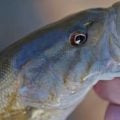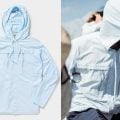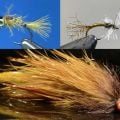Fly Tying: Hair Selection
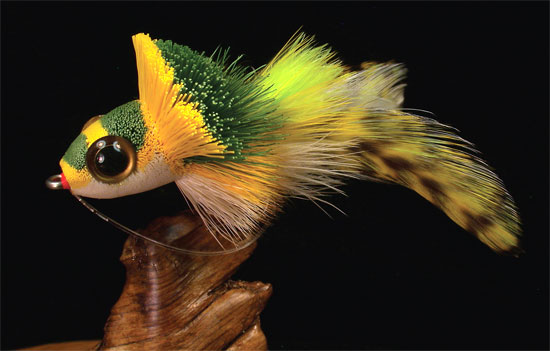
Hair bugs like this are just one of the many ways to use up a deer hide.
SELECTING THE RIGHT HAIR for a fly is one of the hallmarks of an accomplished fly tier. After years of tying with all sorts of hair, you will start to develop a sense of how different types react on the hook when you apply thread tension.
For our purposes here, I will talk about hair from deer, elk, and moose, and calf body hair. Caribou and antelope both have useable hair for fly tying, but I think the only ones who find this stuff useful are the caribou and antelope. These hairs tend to be soft and have mostly broken tips, rendering them useless for wings and collars. While these soft hairs do spin nicely, I find nice thick deer hair to be much better for spinning. A little more skill may be involved in spinning deer rather than antelope and caribou, but the result is more durable and certainly looks cleaner to my eye.
Hair and Tip Characteristics
While deer, elk, and moose hairs float well, they are not hollow like a drinking straw. Instead, they are cellular in nature, more like a piece of cork inside of a drinking straw. The differences in texture between different types of hairs results from a combination of the hair’s diameter and wall thickness, sometimes referred to as the hardness of the hair. The outside wall thickness determines how much the hair can be compressed with the thread and the degree to which it flares on the hook. Thicker walls prevent the hair from being completely compressed under thread pressure or just don’t compress as much as thinner-walled hairs. Thicker walls also make the finished fly more durable.

Bull elk hair tips. Note the small degree of flare.
The larger the inside diameter, or more air space you have in the center of the hair, the better it will float. Too much inside diameter, or air space, and the hair flares wildly. Thick hair (large outside diameter) with thin walls and lots of inside diameter like deer rump and body hair is great for spinning but hard to tame into a decent looking wing on a fly like an Elk Hair Caddis. Hairs with a thick wall and little inside diameter, like moose and elk hock, flare very little or not at all and are great for tailing dry flies because they are manageable and form a straight, stiff tail that supports the heavy hook bend without deforming.
When selecting hair for any fly with hair tips used as a wing or tail, choose hair with quickly tapering, short tips. These short-tipped hairs are more hollow (have a bigger inside diameter) toward their tips, providing air space and adding buoyancy to the finished fly. Long tips are typically dark-colored and solid, adding no floatation to the fly and making the hair harder to compress. Broken hair tips are absolutely unacceptable in my book, and I go to great lengths to avoid them. I always carefully remove any broken tips I see in a stacked bunch of hair before tying it to the hook.
All hair is good for something, but it may or may not be just right for what you have in mind. When you buy a new chunk of hair and sit down to tie with it, take stock of its attributes and perceived applications. When you find a piece that works wonderfully for this or that, write it on the back of the hide with a permanent marker. I have a whole box of hair labeled with things like “Stimi,””EHC” (Elk Hair Caddis),”Humpies,” and “spinning hair.” This labeling system keeps me from having to go through that trial and error each time I sit down to tie a new fly. Also, it’s not a bad idea to leave a little hair left on the patch when you are running down to the end. Bring the remaining chunk of hair with you when you go to the fly shop to buy a new piece to compare the old with the new to match up the color and textures. Eventually, you will be able to select hair by looking it over and feeling it in your fingers, but until you have worked with a variety of different textures and consistencies, trial and error will be your best friend.
Types of Hair
Elk Hair

Bull elk hair tied near the butts. Note how much more this hair flares when tied in closer to the butt ends.
Elk hair is perhaps the most useable of all hairs for fly tying. Whether from a bull, cow, or yearling elk, this versatile hair has a beautiful range of colors. I use elk in every application that I can, because it is so commonly available and generally durable and of good quality. There are textural and quality differences between the hair from a bull, cow, or yearling elk, and I will try to explain them here.
Natural Bull Elk
Natural bull elk hair is lighter in color and slightly longer than cow or yearling elk hair. While this hair is hollow and buoyant, the wall thickness near the tips prevents this hair from flaring much.This thick wall makes the hair durable, and it is my hair of choice for many downwing patterns like the Elk Hair Caddis. This is a hard hair, particularly near the tips, but as you get closer to the butt ends of the hair it gains inside diameter and flares well along its base. Its longer length limits it to larger-than average flies. A good piece of bull elk hair should have beautiful tips that taper to short, abrupt points. When stacked, the dark tips form a striking band of color on wings. Bull elk hair has a slightly smaller outside diameter than cow elk hair but a thicker outside diameter than yearling elk.

Natural cow elk tips.
Natural Cow Elk
A good piece of cow elk hair is a fly-tying staple. Cow elk hair is slightly darker and shorter than bull elk hair but also slightly bigger in outside diameter. The texture and color of a good piece of cow elk hair is similar to that of deer body hair, but the wall of the cow elk hair is generally much thicker. Cow elk can be used on patterns like the Elk Hair Caddis, Stimulator, and the Humpy and produces tough, durable flies with a darker tone than if you tied them with yearling elk hair. The overall diameter of the hair is bigger than both the bull and yearling hair, and I find this hair a bit large to use on smaller flies. Like the bull elk hair, a good piece of cow elk has tips that taper quickly to sharp points. Short tips make wings that end all in the same place and create a stark edge rather than longer wispy tips that result in a wing that just sort of fizzles out near the tips. Cow elk hair flares more than bull elk hair.
Yearling Elk
I have fallen in love with yearling elk hair. Yearling elk epitomizes what I search for in a piece of hair to use for wings on flies of all sizes. The soft texture coupled with the quickly tapered tips makes this hair great for nearly all winging applications.The somewhat thinner wall thickness and thinner overall diameter makes this hair easy to compress on the hook, yet it is still thick enough to keep the hair from flaring out of bounds when I apply thread tension. Yearling elk hair is longer than cow elk and often as long as bull, making it useable for a range of fly sizes. The tips of a good piece of yearling elk hair taper quickly to a point just as a good piece of cow or bull hair will, forming clean color bands along the tips of hair wings. I use yearling elk on patterns like the Humpy and Stimulator, as its thin wall and diameter allows me to anchor it to the hook and completely compress it with heavy thread tension. Hair that compresses completely on the shank creates far less bulk than hairs with thicker walls. A great piece of yearling elk hair inspires me with its hidden potential, and I have been known to hoard the good stuff to excess. I am a bad man.

Moose hock hair lashed to the hook. Note the small degree of flare resulting from the hardness of the hair.
Elk and Moose Hock
Elk and moose hock come from the animals’ legs and is a fine hair with sharp tips and very little inside diameter. This solid texture prevents the hair from flaring and makes it great for tailing dry flies. The hard texture of this hair makes it easy to use and durable and resistant to bending and breaking. I have even used this hair for tailing on nymphs, particularly on patterns that have sparse two- or three-fiber tails. Moose hock has a slightly bigger outside diameter than elk hock and is generally much darker (dark brown to jet black) in color. Near the top of the moose’s leg, you can find patches of hock hair that have silvery tips, which makes great tails on little flies. Elk hock is generally a bit more mottled than moose and has a chocolate-brown color with tan tips. These are both beautiful hairs and are the only hair I use to tail dry flies like the Humpy and Royal Wulff.
Moose Body Hair
There was a time when moose body hair was all the rage for dry fly tails on patterns like Wulffs and Humpys. I have replaced moose body hair with moose hock for my tailing applications and expect most other good tiers have also. Moose body hair is much longer than moose hock and is considerably bigger in diameter. Moose body hair is at best a pretty even mix of white and black hairs, and at worst consists of hair that is white from the base up to about the halfway point where it then turns black.The butt ends of moose body hair are thick and spin like deer hair. These days, I most commonly see moose body used in steelhead dry flies because of its large diameter, mottled coloration, and ease of procurement. My biggest issue with moose body hair is that the tips are often ragged and split, making them useless as tails on the perfect flies I strive for. Aside from the less-than-adequate tips, the larger overall diameter of this hair causes it to flare more than I like, even when I use just the very tips of the hair.

Spinning, flaring, and stacking hair creates spots, stripes and bands on hair bugs like this. Hair bugs are fun to tie but can be time-consuming.
Deer Body Hair
Deer body hair is long and has mottled tips, a thin wall, and a large inside diameter. Deer body hair can come from the body of a whitetail or mule deer, and there are significant differences in the color of the hair from either species. Mule deer hair tends to lean more toward a mousy gray brown color with dark mottled tips, while whitetail hair is more of a creamy tan shade with lighter tips. I’ve always read directions in other books that say to use hair from along the back for this use, and hair from along the flanks for that use and wondered how many people really go out and buy an entire deer hide? Generally, you’re faced with a wall of hair at the local fly shop, all cut into tidy little rectangles with no indication of which body part they formerly occupied. Knowing what to look for in these little chunks will serve you much better than learning the entire anatomy of the deer.

Mule deer body hair attached to the hook. Note the tips and degree of flare.
We will use deer body hair for the Comparadun wing and the body on the Goddard Caddis. For the Goddard Caddis, you want the hair to spin, so look for deer hair with long butt ends with large diameters and thin walls. Picking out a piece of hair with larger diameter butts is easy enough, but trying to determine wall thickness requires a little trick. Press your thumbnail into the hair at its base and note how much the hair flares under pressure. Hair that buckles up wildly is what you want; hair that merely stands up a little probably has walls that are too thick for a fly like this.The condition of the tips of the hair is of little consequence, as you will be cutting them off before tying the hair to the hook. I typically select this hair to have all of the above characteristics as well as nicely mottled tips.The tips can come into play on larger flies with spun deer hair heads and collars, so you may as well try to kill both birds with one piece of hair.The large butt diameter of this hair contributes to the floatation of the finished fly, while the thin wall makes the hair easier to compress, flare, and spin around the hook.
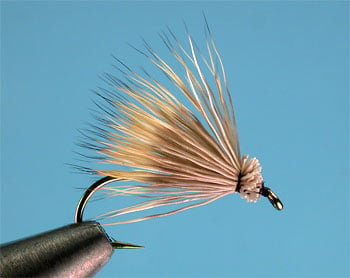
Short "Comparadun" whitetail deer hair attached to the hook. Note the larger degree of flare and short tips.
Conversely, the tips of the hair you’ll use for the Comparadun need to be quickly tapered to a sharp point and have a short overall length with slightly larger diameter butts.This hair is often sold as Comparadun Hair and usually comes from a whitetail deer, although it is sometimes from coastal deer that resemble mule deer hair more than that of a whitetail.This short deer body hair needs to have quickly tapered tips to form the wing on the Comparadun so there is still some hollowness to the hair at the tips. Hair with long wispy tips may be useable for larger-sized flies, but on smaller #18s or #20s, where the proportionate wing length becomes much shorter, these wispy tips provide no floatation and do not flare as well as hair with more diameter.You want the butt ends of the Comparadun hair to be larger diameter so they flare on the shank when you tie them down, spreading the tips in a nice arc across the top of the shank, which helps the fly float.
Deer Belly Hair
Deer belly hair comes from a whitetail deer and is a bright white color in its natural state.This white hair takes dyes extremely well, which produces vibrant, colorful hair.The tips of deer belly hair are generally pretty ragged, but this is of little concern as this hair is typically used for spinning large bass bugs and similar flies.This hair is large diameter with a thin wall (but not as thin as deer body hair) and has a somewhat waxy texture. Deer belly hair is coarser and slightly stiffer than deer body hair but spins beautifully and creates durable hair bodies. Its larger diameter makes it a bit harder to work with than body hair, but the somewhat thicker wall also makes this hair more durable. I find this hair a bit coarse to work with on smaller trout flies, but love it for my bigger hair-bodied bass flies. Incidentally, dyeing the hair can change its characteristics, but this usually stems from a subpar dye job that uses too much heat. Quality hair dyed by companies like Nature’s Spirit is a pleasure to use.
Calf Body Hair
A good piece of calf body hair will be one of your best finds. Calf body hair is fine and often somewhat wavy. The most useable calf hair is dense and straight, making it much easier to clean and stack than its wavy counterparts. Tiers come into the shop all the time complaining about the overall quality of calf body hair, and for the most part I have to agree with them. Most commercially available calf hair is extremely short, wavy, and sparse, rendering it perhaps the most frustrating of all materials to work with. A bad piece of calf body hair is enough to make you give up on the hair and look for an alternative.
So, what to do? Keep looking. There is some good hair out there. In my shop, I typically order calf hair two dozen pieces at a time. Out of those twenty-four patches of hair, a little more than half is useable, and the remainder is typically garbage and goes back to the supplier. Most shops just put them all on the peg and leave it up to you to know what to look for.The inherent process of elimination leaves these weak links on the peg for eternity, and the shop owner doesn’t order any more because, well,the peg is full.What’s left for you is the garbage.Ask your favorite shop’s fly-tying guru to order a new batch of hair and perhaps even bribe him into letting you high-grade through the patches when they arrive. Tying gurus are easily bought off with shiny bits of flash and pretty materials, not unlike crows or raccoons.
Once you have a new batch of calf hair in front of you, look for densely packed hair with few bare spots or sparse areas. You’ll want hair that is as straight as possible, although if a small portion of the patch is wavy and the rest is straight, it is still a viable candidate. Calf hair is generally short, but select the longest hair that you can find. If you can find a patch with hair that is three-quarters of an inch or longer, you are doing pretty well. Check for nicely tapered and intact tips; broken tips on calf hair ruin the overall effect you want on flies like Royal Wulffs and other hairwings.When you find good calf hair, grab several pieces so you’ll have them when you need them.








